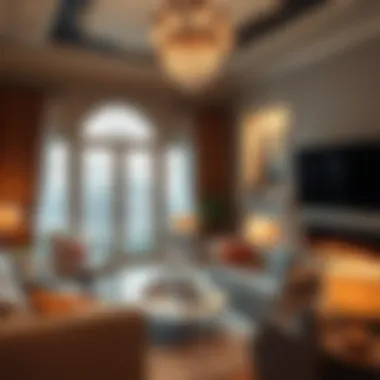A Guide to Local Lighting Shops and Design Insights


Intro
When it comes to creating a home that reflects your personality and style, lighting plays an essential role. It's not just about illuminating your space; it's about setting the mood, enhancing the architectural features, and making a statement. Local lighting shops often serve as treasure troves for those looking to find the perfect fixtures that not only meet functional needs but also resonate with personal aesthetic preferences.
This guide explores everything you need to know about local lighting shops, highlighting the diverse types of establishments you might encounter, the range of product offerings available, and how to make informed choices as a consumer. Delving into how quality lighting can elevate interior design, the article will touch on design principles that marry functionality with visual appeal. We will also reflect on contemporary considerations like sustainability and innovation, ensuring that whether you’re a homeowner, designer, or simply a lighting enthusiast, this roadmap will enlighten your exploration.
Furniture Styles and Trends
Lighting, like furniture, is influenced by trends that shift with the seasons. Understanding furniture styles can help you choose the right lighting to create harmony within your space.
Modern vs. Traditional: Understanding the Aesthetics
Modern lighting often embodies minimalism, favoring sleek designs with a focus on clean lines and functionality. Think about fixtures made of metals like brushed nickel and materials like glass or acrylic. They typically embrace a monochromatic palette, focusing on simplicity and elegance.
On the other hand, traditional lighting styles may incorporate ornate details and warm finishes, offering a cozy feel to a room. Think of brass chandeliers and vintage sconces adorned with crystals. This style tends to emphasize craftsmanship and, in many cases, reflects historical design trends.
When selecting lighting, marrying these aesthetics with the existing furniture can create a cohesive look that speaks to both contemporary and classic influences.
Color and Material Trends: What's In and What's Out
Color trends in lighting are as dynamic as those in paint and decor. Currently, earthy tones have surged in popularity, with warm bronze, terracotta, and muted greens taking center stage. These colors don’t just add visual interest; they create a calming atmosphere that can enhance any space.
Material trends also evolve. While glass and metal continue to reign supreme, the rise of sustainable materials, such as reclaimed wood or recycled metals, is becoming paramount among environmentally-conscious consumers. Shoppers are increasingly inclined to explore fixtures that not only suit their style but also reflect their values.
"Choosing the right lighting isn’t just about visibility; it's about creating a narrative in your space."
At the culmination of your visit to a local shop, you may find yourself not only drawn to particular styles and colors but also influenced by ethical considerations. Each decision regarding lighting can echo broader themes of sustainability, leading toward choices that are both stylish and responsible.
Finding the Right Local Lighting Shop
So, where do you start your quest for the perfect lighting?
Exploring local shops is often the best way to discover unique pieces that mass retailers simply can’t offer. Here are some tips for locating these hidden gems:
- Seek Recommendations: Ask friends or family for suggestions. Word-of-mouth can lead you to shops known for exceptional service and quality.
- Utilize Online Resources: Websites like Facebook, Yelp, or local community forums (like Reddit) can reveal local favorites and new arrivals.
- Visit Local Craft Fairs or Home Shows: Often, local artisans showcase their work in these settings. You may stumble upon innovative designs or styles not found in larger stores.
- Explore Social Media: Many local shops maintain an online presence. Checking Instagram or Pinterest is a great way to discover not just their inventory, but also their unique approach to lighting design.
Understanding the Importance of Lighting
Lighting plays a pivotal role in transforming spaces, giving them a personality and functionality that can either elevate or diminish the overall aesthetic. A well-lit room enhances the ambiance, sustains energy, and can even affect one’s mood. This section highlights why lighting should never be an afterthought, but rather a fundamental component of any design strategy.
The Role of Lighting in Interior Design
Interior design often demands a careful balance between aesthetics, comfort, and practicality. That's where lighting comes into play. Effective lighting resolves conflicts between contrasting elements in a room, such as color schemes, textures, and furniture arrangements. For instance, in a cozy living room, warm-toned lights can create an inviting atmosphere, while cooler lights might take center stage in a more modern, open concept.
Consider these factors when scrutinizing the role of lighting:
- Enhancement of Architectural Features: Good lighting can highlight a room's best attributes. Arches or beams, for instance, look more dramatic under the right spotlight.
- Creating Zones: In open spaces, lighting can define separate areas for relaxation or conversation without the need for physical dividers. It allows for a more fluid and open living experience.
- Psychological Impact: Research suggests lighting affects our emotions. Soft lighting can foster calmness, making it ideal for bedrooms and lounges.
A well-considered lighting plan can breathe life into even the dullest of spaces, making it indispensable for homeowners, designers, and decor aficionados.
Types of Lighting: Ambient, Task, and Accent
Understanding the different types of lighting is vital for curating an inviting yet functional environment. The three primary categories encompass ambient, task, and accent lighting. Each type serves its unique purpose and can greatly impact the overall feel of a space.
- Ambient Lighting: Think of this as the base layer. It’s general illumination that fills a room and ensures visibility. Natural light from windows serves as an excellent example of ambient lighting, complemented by overhead fixtures like chandeliers or ceiling-mounted lights. This type helps establish a room's atmosphere.
- Task Lighting: As the name suggests, task lighting aims to aid specific tasks like reading or cooking. Table lamps, under-cabinet lights in kitchens, or pendant lights over workspaces are some examples worth considering. It’s crucial that this type of lighting is bright enough to prevent strain, while still blending seamlessly into the overall design.
- Accent Lighting: This type brings attention to particular features, such as artwork or architectural details. Spotlights, wall sconces, or directional lights can create focal points that draw the eye and add visual interest.
In essence, a successful lighting scheme weaves together these types into a cohesive design that speaks to both form and function.


"Lighting is not only about utility. It's about creating an atmosphere that invites, uplifts, and enchants."
Understanding these layers of light isn't merely for show; they are essential considerations for anyone passionate about design, helping to make informed choices in their quest for the ideal lighting solutions.
Characteristics of Quality Lighting Shops
When you set foot into a lighting shop, it's not just about the glimmer of the newest bulb or chandelier. The vibe and offerings shape your experience, catching your eye more than what you may have expected. Identifying the qualities that separate average lighting shops from exceptional ones is essential for anyone looking to enhance their living space.
Product Range and Variety
The diversity of the product range is a significant element that speaks volumes about the quality of a lighting shop. You want options that cater to various tastes and needs. A good lighting shop should boast a broad selection that covers everything from the latest in LED technology to classic vintage pieces.
Common choices available include:
- Ambient Lighting: Lighting that sets the overall tone of a room.
- Task Lighting: More focused illuminations for specific activities like reading or cooking.
- Accent Lighting: Spotlights that draw attention to artwork or architectural features.
Having a variety of products not only ensures you find what you’re after, but it also helps in inspiring your creativity. If a shop carries an eclectic mix of styles, it lends itself as a playground for designers and DIY enthusiasts alike. You could stumble upon a unique pendant lamp that perfectly encapsulates your vision, even if you didn't know you needed it!
Knowledgeable Staff and Customer Service
Quality staff can turn an ordinary shopping trip into a valuable learning experience. Knowledgeable staff are essential for any lighting shop that wants to build relationships with its clientele. They should possess a deep understanding of product features, installation processes, and how different types of lighting can impact a room's atmosphere.
Customer service also plays a big role. When you enter a lighting shop, the staff should make you feel welcomed and valued. Whether it's recommending the right fixture for your needs or providing insights about energy efficiency, a supportive and approachable team can elevate your experience. Take note of how they respond to your questions; do they take the time to understand your requirements? Are they eager to offer suggestions? These factors matter greatly in deciding whether a shop is worth your time.
Affordability vs. Quality
Let's face it; price often dictates why we choose one shop over another. A common misconception is that higher prices always equate to better quality. While it's true that you often get what you pay for, it’s crucial to evaluate whether a lighting shop offers value for money.
- Affordable Choices: A good shop will present options across different budget ranges without compromising quality. Just because a light fixture is inexpensive doesn't mean it's poorly made.
- Premium Selections: On the flip side, higher-priced items can often afford improved aesthetics and better durability. A well-made fixture can elevate a space whilst significantly outlasting its cheaper counterparts.
In this tug-of-war between affordability and quality, it’s essential to strike a balance. Assess your needs, budget, and the type of lighting that will serve both your functional and aesthetic desires.
Ultimately, the best lighting shop will harmonize a range of products, knowledgeable staff, and visible value in their offerings.
Finding the right lighting shop can feel a bit like searching for a needle in a haystack, but understanding these characteristics will help narrow down the candidates. Engage, ask questions, and don’t hesitate to explore multiple shops until you find the one that meets your style and needs.
Learn more about shopping locally at Wikipedia or explore design inspiration on Pinterest.
Finding Lighting Shops Nearby
Finding the right lighting shop is a critical step not just for the design of your spaces but also for ensuring that you get quality products and advice tailored to your needs. The world of lighting can be overwhelming with its array of styles, types, and technologies. So, knowing where to procure your lighting solutions makes all the difference. This section untangles the process of finding lighting shops close to home, emphasizing both the ease of access and the variety of options available to consumers.
Utilizing Online Resources and Directories
In today's digital age, the Internet is a treasure trove of information, and hunting for nearby lighting shops is no exception. Online directories can offer a wealth of options at your fingertips. Websites like Google Maps or Yelp allow you to search for local shops simply by typing in keywords like "lighting store" or "lighting retailer."
On platforms like these, you can see user reviews and ratings, which provide a glimpse into the quality of products and the level of customer service you might expect. Be sure to check for specifics, such as:
- Operating hours: Not all shops keep the same hours, so finding places that are open during your schedule is key.
- Services offered: Some shops provide additional services like installation or consultation, which could be beneficial for your project.
- Location: Consider how far you’re willing to travel. Is it a quick drive or a bit of a trek?
Remember, when perusing directories, you can often find special promotions or discounts that local shops may be offering, offering you another reason to visit in person.
Leveraging Social Media and Community Recommendations
Social media has reshaped how we find and interact with local businesses. Platforms like Facebook or Instagram allow for engagement that goes beyond traditional advertising. You can follow local lighting shops to keep up with their newest arrivals, trends, or even sales. Moreover, seeing their posts offers a real-time showcase of how the products look in actual settings.
Communities on platforms like Reddit can also be gold mines for information. Subreddits dedicated to home design or local town discussions often have users sharing their experiences and recommendations about lighting stores. Here’s how to leverage these platforms effectively:


- Join relevant groups: Look for local home improvement or design groups. Members often share tips or favorite stores, making your search easier.
- Ask open-ended questions: Engage with the community by asking for lighting shop suggestions. This can lead to recommendations based on personal experiences.
- Follow hashtags: On Instagram, hashtags like #LightingDesign or #HomeDecor can lead you to both stores and inspiration on how to use lighting creatively.
As you explore these digital venues, take note: nothing beats the insight that comes from those who have been in your shoes. In the end, a little bit of online research combined with community insight can be your secret sauce to discovering the perfect lighting shop nearby.
"Finding the right lighting shop is not just about the products they have, but also the knowledge and service that can help in making your space shine."
By utilizing both online tools and tapping into community wisdom, you're well on your way to uncovering those local gems that will not only brighten your home but also enhance your personal style.
Types of Lighting Shops to Explore
Exploring different types of lighting shops is critical for anyone on a quest to enhance their living spaces. Each shop offers a unique array of styles and solutions, catering to diverse preferences and needs. Knowing where to shop can make a world of difference in achieving not just the right ambiance, but also in ensuring that the products align with sustainable practices and innovative designs.
Specialty Lighting Stores
Specialty lighting stores often have a curated selection of unique pieces that you may not find in larger retailers. These shops focus on specific styles, such as modern, rustic, or industrial, allowing customers to find fixtures that truly resonate with their personal taste.
Moreover, the staff in these specialized stores typically possesses extensive knowledge about the nuances of each product. They can provide valuable advice on how different lights might work in your space. This level of expertise can turn a simple shopping trip into an enlightening experience—pun intended. Specialty stores also tend to support local artisans and eco-friendly brands, providing options that align with sustainable values.
"In specialty lighting stores, every fixture tells a story, connecting aesthetics with functionality."
Home Improvement Retailers
Home improvement retailers are the giants in the industry. They often feature a broad selection of lighting, from the mainstream to the innovative. When visiting these stores, shoppers can find everything from recessed lighting to chandeliers. The benefit of these mega-stores is the ability to view many options in one go and often at competitive prices.
However, buyers should be aware that while prices can be appealing, the guidance on making selections may not be as personalized. Staff could be less specialized compared to a niche store, so thorough research beforehand can help in making well-informed choices. It is beneficial to bring along a list of what you need and perhaps some measurements to ensure your selections fit well in your intended spaces.
Flea Markets and Vintage Shops
Flea markets and vintage shops offer a treasure trove of one-of-a-kind lighting fixtures that can breathe new life into your home. Often misunderstood, these venues provide a unique mix of old-world charm and contemporary aesthetics. Shoppers can uncover rare finds, such as vintage lamps or repurposed light fixtures, that are rich in character and history.
Additionally, purchasing from these shops often supports local economies and small businesses. While you may need to be more patient in your search, the reward of discovering that perfect statement piece not only feels good but can also spark intriguing conversations.
Keeping an open mind while browsing these shops is key. It’s common to need a little creativity to visualize how a vintage piece might fit into a modern space, but the results can be striking. A vintage lamp on a sleek, modern desk, for instance, can create a beautiful contrast that enhances the decor.
As a part of your shopping journey, remember that the options for sourcing lighting are diverse and plentiful. Each type of shop offers its own set of advantages and unique products that cater to a wide array of tastes and needs.
Sustainability in Lighting Choices
As the world takes the green turn, sustainability in lighting has carved a vital niche in both interior design and consumer choices. Homeowners and designers alike are increasingly aware of the impact their selections have on the environment. Making sustainable choices in lighting not only reflects responsible stewardship but also serves practical purposes in energy conservation and cost savings. When one ponders sustainability, it is important to reflect on various angles—energy efficiency, ecological impacts, and long-term benefits.
Energy-Efficient Lighting Solutions
In the grand scheme of things, energy-efficient lighting is not just a trend; it is an essential movement in optimizing consumption and minimizing waste. Traditional incandescent bulbs, while creating a warm glow, drain more resources than modern solutions. Switching to LED lighting, for instance, makes a monumental difference. Here’s why:
- Longevity: LED bulbs can last up to 25,000 hours compared to about 1,000 hours for incandescent options. You replace them less often, which decreases landfill waste.
- Lower Energy Bills: LEDs consume about 75% less energy than incandescent bulbs, which is a welcome relief for the wallet.
- Less Heat: These bulbs emit very little heat, making them safer in enclosed spaces and reducing air conditioning costs in warmer months.
It’s like asking the question—why throw money out the window when you can pocket it by simply choosing the right bulb? The upfront cost of LED lighting might seem considerable, but the savings over time can make that initial price tag a non-issue.
Eco-Friendly Materials in Lighting Design
Beyond the light source itself, the materials utilized in designing fixtures play a pivotal role in fostering sustainability. Consumers today are on the lookout for products that come from recycled or renewable materials. Whether it’s a stylish lamp made of reclaimed wood or a pendant crafted from recycled glass, the principles remain the same:
- Recycling and Upcycling: Environmental responsibility starts with the materials used. Engaging with shops or brands that prioritize sustainability means supporting a circular economy. When lighting designs recycle materials, less waste clutters landfills.
- Sustainable Sourcing: Manufacturers that source raw materials ethically not only contribute to environmental health but also elevate the whole industry by setting higher standards for production.
- Non-Toxic Paints and Finishes: Many finishes used in lighting designs contain harmful chemicals. Opting for eco-friendly options can aid in reducing indoor pollutants, thereby improving air quality.
"Sustainable practices in lighting are not only good for business, they are essential for the well-being of future generations."
For further reading on sustainable design principles, you can visit Wikipedia or explore more insights from Britannica.


Look out for local shops that embrace these sustainable principles to illuminate your space responsibly.
The Future of Lighting Retail
As we navigate through a world increasingly shaped by technology and environmental consciousness, the future of lighting retail becomes crucial in redefining how we perceive and engage with our living spaces. Shifts in consumer behavior, technological advancements, and a growing emphasis on sustainability are reshaping the landscape of lighting shops. This section highlights the significant trends and considerations that define the future of this industry, making it essential for homeowners, designers, and retailers alike to stay informed and open-minded.
Trends in Smart Lighting Solutions
One of the most notable trends in lighting retail is the proliferation of smart lighting solutions. These products offer much more than aesthetic appeal; they provide functionality that aligns with modern demands for convenience and control. Home automation is no longer a luxury but rather an expectation among consumers who want to manage their environment through apps and voice commands. These smart systems allow users to adjust brightness, change colors, and create ambiance with a simple tap or a voice prompt.
- Energy Efficiency: Smart lights often utilize LED technology, which not only enhances longevity but also minimizes energy consumption.
- User-Centric Designs: Today’s smart lights come with design choices that can fit various interior aesthetics, whether one leans towards modern chic or rustic charm.
- Connectivity: The integration with existing smart home platforms such as Alexa and Google Home makes these solutions highly appealing.
"The integration of technology in everyday living spaces not only boosts efficiency but also provides homeowners with a touch of luxury in daily life."
Integration of Technology in Retail Experience
Just as smart lighting transforms home environments, the integration of technology within retail spaces plays a fundamental role in refining the customer experience. Lighting shops are beginning to leverage technological tools to create immersive and personalized shopping experiences. Here are several predominant elements to consider:
- Augmented Reality (AR): Consumers can visualize how a light fixture will look in their home before making a purchase. Imagine holding up your phone and seeing a lamp fitted into your living room as if it were already there.
- Interactive Displays: These in-store setups allow customers to engage with various lighting options, experimenting with brightness, color settings, and even temperature to find the perfect match for their style.
- E-commerce Enhancements: Many retailers are refining their online platforms by incorporating AI-driven recommendations based on customer preferences and browsing history, providing personalized suggestions that can lead to higher satisfaction and increased sales.
- Virtual Consultations: The option for virtual consultations with lighting professionals is becoming common, enabling customers to receive expert advice on lighting styles and installations from the comfort of their homes.
Making Informed Decisions when Purchasing
When it comes to buying lighting, making an informed decision is crucial. It's not just about finding a good deal; it's about understanding how lighting influences your space and lifestyle. Factors such as style, functionality, and maintenance can greatly affect both the atmosphere of your home and the longevity of your investment. Knowing what to consider before making a purchase can save you from buyer's remorse.
Considering Style and Functionality
Choosing lighting that complements both the style and functionality of your space requires a careful approach. Generally, different rooms call for various styles and purposes of lighting.
- Identify the Atmosphere: Are you going for a cozy feel in the living room or a bright and energizing vibe in the kitchen? The goal determines the lighting style you should choose.
- Style Matching: For example, a mid-century modern decor may be complemented well by sleek designs found in stores like West Elm or CB2, while more rustic homes might benefit from vintage-inspired fixtures seen in shops like Anthropologie.
- Layering Lighting: Consider how different types of lighting work together—ambient, task, and accent lighting can create a well-rounded illumination.
Selecting the right fixture isn't merely about aesthetics; it's also about how the light functions. A pendant light over your dining table should be both decorative and effective for illuminating meals without being blinding.
Understanding Installation and Maintenance Needs
Before pulling the trigger on a lighting purchase, consider how easy it will be to install and maintain the product. This can often be the less glamorous side of buying new lights but is equally important for avoiding future headaches.
- Installation Requirements: Some lighting fixtures may require professional installation, while others can be easily mounted or plugged in by yourself. High ceiling chandeliers, for instance, often necessitate an electrician, which adds to the overall cost.
- Maintenance Considerations: Think about the upkeep involved. Will you need to change bulbs frequently? Is the fixture easy to clean? For instance, intricate designs can collect dust quickly, while simpler, sleeker fixtures are often easier to maintain.
A handy tip is to look for products designed for longevity, like LED options, which not only consume less energy but also have a longer lifespan than traditional bulbs, decreasing the hassle of frequent replacements.
Before making that final decision on lighting, guide yourself by your personal needs and the practical aspects that contribute to longevity and usability.
All in all, spending a little extra time on understanding style choices and installation needs can greatly enhance your satisfaction with any new lighting purchase. The right choices can result in long-term benefits, both aesthetically and functionally, making your space truly come alive.
Networking and Building Relationships in the Industry
In the realm of local lighting shops, networking and building relationships present a golden opportunity for both consumers and industry professionals. Establishing connections can enhance the shopping experience, improve product knowledge, and foster a sense of community among design enthusiasts.
When you step into a lighting shop, blending expertise with personal interaction often makes the process of choosing lighting solutions more straightforward and enjoyable. Building relationships with shop owners and employees not only helps you gain insights into the latest trends and technologies but also creates a space for collaboration, allowing everyone to learn and grow together.
Collaborating with Local Designers
Working hand-in-hand with local designers can bring mutual benefits. Designers often have in-depth knowledge of lighting solutions that blend aesthetics with functionality. By collaborating with them, local shops can curate their offerings to match client aspirations, ultimately elevating the shopping experience.
These designers serve as trendsetters and innovators. When they visit local lighting stores, they can bring fresh ideas, fostering a dialogue about which products might resonate with customers. This can lead to tailored events or workshops in-store, where designers share their insights with decorators and homeowners. Practical workshops not only create buzz, but also help participants visualize various lighting setups they can implement in their own spaces.
Engaging with Decor Enthusiasts and Communities
Evidently, the heart of any local lighting shop thrives on its community. Engaging with decor enthusiasts can cultivate a loyal customer base. The more you connect with local communities—be it through hosting events, participating in social media discussions, or sponsoring local art displays—the more you illuminate your shop’s standing in the minds of potential customers.
Consider creating online platforms, such as Facebook groups or Reddit threads, where these enthusiasts can share ideas and inspire one another. A lively discussion about current trends or favorite designs can spur interest in in-store products. Engaging with customers means listening to their preferences, asking what they look for in lighting, and integrating that feedback into your offerings.
"Building a community means entering a relationship where listening to the needs and preferences of customers can drive innovation and satisfaction."















